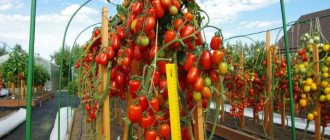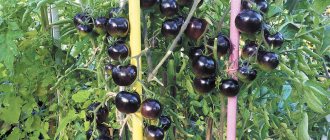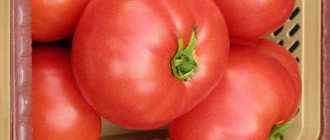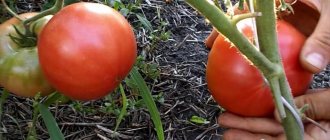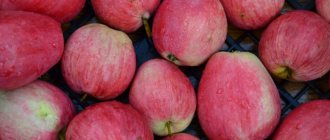History of variety development
This tomato variety was bred by the Ukrainian breeder D. Terentyev. Currently, the seeds of this tomato are presented on the market by the Russian agricultural company Partner.
The variety was bred in the first quarter of this century, and was presented to gardeners in 2022.
Photo of tomato Black Goddess
According to the description of specialists from the Partner company, the Black Goddess variety is recommended for cultivation in the Moscow region, the middle zone and other Russian regions with similar climatic conditions. The Black Goddess tomato can be cultivated in garden beds and in greenhouse conditions, but the seed manufacturer recommends growing in protected soil to obtain maximum yield.
Working with seed material
Seeds are treated before planting. There are several ways to disinfect planting material. The simplest and most reliable is disinfection in a pink solution of potassium permanganate for 15-20 minutes, followed by rinsing with running water.
Seed germination is necessary for:
- determining the percentage of germination;
- good stimulation of further vegetative process.
The procedure is performed like this:
- Cotton fabric folded in several layers and soaked in water is placed at the bottom of the container.
- The seeds are laid out on it.
- The container is sealed with a lid to maintain moisture.
The seeds should not end up in water, as this will cause them to rot. The whole process occurs at room temperature and is completed when the white sprouts are equal in length to the seeds. This usually takes 4-5 days.
Sowing seeds for seedlings
Currently, various types of soils are commercially available. Any type is suitable for tomato seedlings. Your own garden soil, prepared in the fall, must first be disinfected. This can be done by pouring it with the same pink solution of potassium permanganate and then drying it.
At this stage, it is necessary to take care of feeding future plants. The substrate is filled with a full mineral complex NPK (nitrogen, phosphorus, potassium) in the proportion of one tablespoon of soil per bucket of soil.
To avoid traumatic picking of seedlings, sowing should be carried out immediately in separate small containers. Sowing depth 1 cm.
Shoots can be expected in 5-6 days.
Seedling care
Regular watering is the main concern. It should be carried out as soon as the top layer of soil dries. Excessive waterlogging of the soil can cause root rot.
Young shoots on the windowsill are drawn towards the light, which leads to their curvature. This can be compensated for by rotating the seedlings.
Deepening the stems of seedlings allows the root system to grow, and the above-ground part will develop proportionally. If you sow the seeds in cups half filled with soil, then later, when the seedlings grow, you can pour the substrate into the containers and stimulate root growth. After these plants have grown, transshipment should be done. The seedlings are transplanted into larger containers, preserving the earthen ball and deepening the stem to the lower leaves.
Planting seedlings in the ground
To obtain maximum yield and quality fruits, the planting density of tomatoes should not exceed 4 bushes per square meter. Depending on the format of the beds, this leads to planting patterns of 50x50 or 60x40 cm.
A teaspoon of NPK fertilizer is first added to the planting hole and mixed with the soil. It is also necessary to take care in advance about supports for future gartering of bushes. If the seedlings are overgrown, they can be planted obliquely (lying down) so as not to unnecessarily deepen the root system.
Tomato Black Goddess: variety description
This tomato is mid-season - from the moment the seed germinates until the ripe tomatoes are harvested, it takes up to 3.5-4 months.
Bushes
Tomato Black Goddess is an indeterminate type
, therefore the central shoots of tomato bushes are not limited in growth.
Typically, the height of shoots when grown in greenhouse conditions reaches 2 m, while many vegetable growers pinch the tops of shoots at a lower height if the height of the greenhouse is less than the height of the bush. But when grown in garden beds, the height of tomato bushes is usually about 1.7-1.8 m.
Review of tomato BLACK GODDESS
Due to the large height of the bushes, they need to be tied to supports when grown in garden beds, and in greenhouse conditions trellises are used for this
. Also, stepsons constantly appear on tomatoes of this variety, which must be removed so that they do not take away the nutrients necessary for the formation and ripening of the fruit.
Important!
To improve productivity, it is recommended to form the indeterminate tomato variety Black Goddess into no more than 1-2 shoots.
The central and lateral shoots are medium leafy. The foliage is typical of tomatoes, elongated, with sharp tips and sparse small teeth along the edges. The leaf blades are slightly wrinkled, have a characteristic shine and a rich dark emerald color.
The flowers are small in size, with 5 yellow petals, collected in simple racemose inflorescences, the first of which is formed under the 8 leaf plate, and each subsequent one - through 3 plates.
Fruit
Ripe tomatoes are flat-round in shape; as they ripen, their skin acquires an orange color with a red tint at the apical part, and most of the tomato has a dark purple color. Tomatoes acquire a dark color if they are constantly exposed to sunlight during ripening.
If tomato bushes are grown in shade or partial shade, then the color of the tomatoes will be brown with streaks of brown or black color.
The fruits of the Black Goddess tomato are medium in size, usually weighing up to 120 g.
The skin is dense, smooth and even, without ribbing. The pulp is dark pink, dense and sweet, with a characteristic crunch.
. But when grown in the shade and lack of sun, sourness appears in the fruits, and the amount of sugars decreases. The pulp may contain 2-3 seed chambers with a small amount of liquid and an average number of seeds.
Reference!
The color of the skin is due to the presence of anthocyanin in its composition, a strong antioxidant that prevents the development of free radicals in the human body.
Among other beneficial substances contained in the Black Goddess tomato fruit, it should be noted:
- Sahara;
- starch;
- vitamins of group B, A;
- violet acid;
- lycopene;
- choline
If you consume the fruits of this tomato regularly, the walls of blood vessels will be strengthened, immunity will increase, and swelling will disappear. Lycopene will improve the functioning of the prostate gland in men, and thanks to vitamin A, vision will improve.
Thanks to the dense skin, the collected fruits are not prone to cracking, tolerate transportation well over different distances and have good shelf life.
Description of the variety
The price for seed material of the ancient Italian variety Aruzzo is moderate.
Is it worth planting Black Goddess tomatoes in your garden plot?
The Black Goddess tomato has a peculiarity - the active formation of stepsons, which are often superfluous, but in case of hail damage they help restore growth.
The regeneration of tomato plants depends on the location of the hail strike, and if the impact falls on the upper part of the stem, then it is quickly restored by the lower stepsons and, even if the lower part of the stem is damaged, 1-2 buds always remain in the axils of the lower leaves.
The fruits of this variety are remarkable in shape and color. Maintenance is easy. The yield in a greenhouse will be significantly higher than in open ground. The price of seed material is low.
Characteristics of the Black Goddess tomato
This tomato variety tolerates short periods of drought well, but does not like stagnant moisture in the soil.
. In this case, root rot may appear on the plants, and the fruits begin to burst.
Tomato yield Black Goddess
The harvest begins to ripen in mid-July, and the last ripe tomatoes are harvested even in early August.
Vegetable growers note that with good care and favorable weather conditions, when growing the Black Goddess tomato in a greenhouse, you can harvest at least 4 kg of fruit from each bush, and up to 18 kg of ripe tomatoes from each square of area
.
Area of application of fruits
The harvested crop looks beautiful in summer salads and appetizers, significantly improving their taste. These unusually colored fruits are also used to decorate dishes.
The Black Goddess tomato is great for canning, pickling, and preparing winter salads; tomatoes do not burst during heat treatment.
Beautiful tomato Black Goddess
Characteristics of the variety
The ripening of Black Goddess tomatoes occurs 100-115 days after the appearance of the entrances. The variety is mid-season with a long fruiting period. You can pick original fruits from mid-July to October.
The yield declared by the breeders is 18 kg/sq.m. m. Reviews from vegetable growers who have already grown Black Goddess tomatoes confirm these indicators.
Moreover, many claim that you can achieve greater results if:
- choose sunny places for planting tomatoes;
- treat greenhouses before planting;
- monitor temperature and humidity levels.
All these measures will minimize the risk of late blight affecting plants and extend the growing season.
The most optimal use of Black Goddess tomatoes is fresh consumption. Dark varieties are especially rich in antioxidants, vitamins and microelements. Purple tomatoes will look great in salads and appetizers. The variety is suitable for canning and pickling.
"Pros and cons"
Black Goddess tomatoes are one of the new, still little-studied varieties. But the positive reviews about it make you think. Among the advantages can be noted:
- high-yielding variety with an extended fruiting period;
- original fruits with good taste and commercial qualities;
- resistance to most diseases;
- the variety is designed for cultivation in unpredictable weather conditions; it is a cold-resistant and drought-resistant variety;
- unpretentious in care.
Among the disadvantages it should be noted:
- far from affordable cost of seeds;
- high percentage of fake planting material;
- the need to process and tie up tall bushes.
From the above characteristics of Black Goddess tomatoes, it follows that it has many more advantages than disadvantages. And only the price of seeds can prevent you from growing unique tomatoes on your plot.
Advantages and disadvantages
The main advantages of the Black Goddess variety include:
- good yield indicator;
- versatility of the harvested crop;
- high resistance to diseases and attacks of harmful insects;
- pleasant sweetish taste of tomatoes;
- the ability to collect seed material from ripe fruits;
- good original appearance of ripe fruits.
Among the disadvantages of the Black Goddess tomato, it should be noted that when there is an abundance of moisture, the fruits are prone to cracking; you also have to tie tall shoots to supports and regularly carry out pinching.
Planting tomato Black Goddess
When growing the Black Goddess tomato, you should remember that its bushes grow quite tall, so they require special care.
Growing seedlings
This tomato is grown in seedlings
.
To do this, purchased or collected Black Goddess tomato seeds are planted in early March
in pre-prepared containers with a nutrient substrate. It is purchased in specialized stores or prepared at home.
To do this, take turf, rotted manure and peat in equal parts and mix thoroughly. And for each bucket of this mixture add 15 g of potassium salt, urea and superphosphate.
While the seeds are germinating in containers, they should be covered with film, and the room temperature should be maintained around +24 degrees Celsius
. When the seed material germinates, the film is removed and the air temperature is reduced to 22-23 degrees Celsius.
And in the last week before planting the seedlings in a permanent place, the room temperature should be no more than +18 degrees Celsius.
After about 14-15 days, you can pick up the seedlings into separate cups
, leaving only strong plants. After the seedlings acclimatize after transplantation, they are fed with a humus solution (with a concentration of 1:10).
After a week, it is advisable to re-feed the tomato seedlings using the following mixture:
- 5 liters of water;
- 1 tbsp. l. superphosphate;
- 1 tbsp. l. potassium salts;
- half a teaspoon of urea.
Seedlings can be transplanted into garden beds or greenhouses when the plants have at least 8 true leaves and at least one inflorescence.
All about growing tomatoes - video
Transplanting seedlings
The place where these tomatoes will grow should be well lit by sunlight, and moisture should not accumulate in the soil.
The distance between planting holes should be 50 cm
. A handful of wood ash or rotted manure should be poured into each hole, and on top - a layer of earth on which the seedling is placed. It needs to be buried in the soil up to the first true leaves. Before planting the seedlings, the holes are watered so that the soil settles.
After planting, each plant is watered abundantly and mulched on top with a layer of peat or humus.
Growing tomatoes
Tomatoes can grow in a greenhouse and outdoors
This variety is planted both in greenhouses and in open ground, since it is resistant to temperature changes.
For cultivation, choose areas protected from gusts of wind. Bushes can break if they are not secured to supports. There are some peculiarities in growing these tomatoes.
Growing seedlings
For seedlings, the Black Goddess is sown in the second ten days of March. For the soil mixture, several components are selected in the same ratio:
- turf;
- humus;
- peat.
It is better to use ready-made soil mixture. Turf is not suitable for growing seedlings; it is a heavy soil in its mechanical composition. And the townspeople have practically nowhere to procure it. Turf, sod, is the top layer of soil (10-15 cm), removed from meadows with good cereal or legume forbs. To use turf soil in soil mixtures, this turf must lie in a pile for another 1.5-2 years and rot.
Add 0.5 tsp per 5 kg of prepared mixture. urea and the same amount of potassium sulfate and superphosphate. Sow seeds in cassettes with a retractable bottom. You can also sow them in boxes or containers where picking of seedlings will be necessary.
The optimal temperature for seed germination is 23-25 ℃.
At first, the container with seedlings is covered with film or glass. They are removed when mass shoots appear.
25-30 days after germination, the temperature can be reduced to 20 ℃. 10-12 days before transplanting, a temperature of 19-20 ℃ is allowed, which will harden the seedlings. To do this, you can move the plant to the balcony, but do not expose it to the cold.
You can feed the seedlings for the first time 7-8 days after picking.
To do this, use humus, which is diluted with water 1:10. A week later, a fertilizer is used, which is prepared from 5 liters of water and superphosphate (1 tbsp), to which urea (0.5 tsp) and potassium sulfate (1 tsp) are added.
To feed seedlings, ready-made water-soluble fertilizers such as Aquarin, Mortar, Aquamix, and Crystallon are used. They contain all the substances necessary for young plants in an accessible form and in the required proportions.
Transplanting seedlings
Before transplanting the seedlings, 5-6 leaves and a flower cluster should appear on it. The average length of internodes should vary from 6 to 7 cm.
There are several cultures that are considered the best predecessors for the Black Goddess:
- beans;
- peas;
- rye and wheat;
- corn.
If nightshades were previously grown on the site, it is better to refuse to plant tomatoes in this place.
The distance between plants in a row should be at least 0.5 m, and the row spacing can reach 0.7 m.
The plants are planted in the prepared hole and the first leaves are deepened. Add 3 handfuls of humus and 1 handful of ash to the hole, fill it with water and cover it with soil.
Further care for the Black Goddess tomato
Good fruiting of plants depends on proper care of the bushes of this tomato.
Watering is carried out with settled warm water in the morning or evening hours strictly at the root
. In this case, drops of moisture should not fall on the leaf blades or stems of the bushes. To make water evaporate more slowly, the root zone is mulched with a layer of straw or rotted manure. The thickness of such a layer should be at least 5 cm.
Good varieties!
Tomato Swan Princess F1 Early ripening tomato Agata Tomato Stone flower F1
This tomato should be watered regularly throughout the season, preventing the soil from drying out. After all, the bushes of this tomato continue to bloom and form ovaries even when the already formed fruits ripen.
Advice!
After watering, the root zone of plants should be loosened to ensure access of moisture and air to the roots.
During cultivation, Black Goddess tomato bushes need to be fed three times:
- 12-14 days after planting the seedlings in a permanent place - in a greenhouse or in garden beds;
- during abundant formation of ovaries;
- after the first fruits have been harvested.
If you notice that a lot of flowers form on tomatoes, but there are practically no ovaries, then you need to reduce the amount of nitrogen-containing fertilizers and add superphosphate to the soil.
Black Goddess bushes form 1-2 shoots
, for this, 1 stepson is left under the first inflorescence, from which lateral shoots are formed - fruiting will continue on it after it has practically ended on the central stem. The remaining stepsons are removed.
You should also tie the bushes in several places to strong supports so that they do not break and fall to the ground under the weight of the ripening crop.
Main stages of cultivation
Maximum yield of the indeterminate Black Goddess can be ensured only in greenhouses and using the seedling method. All calculations of the tomato work schedule are made from the moment the seedlings are rooted in the ground, when the soil warms up to +15 0C, and the air temperature remains stable at +20 0C.
In the central regions of Russia, in unprotected soil, this occurs in late May - early June. Here, seedlings are planted in greenhouses and under temporary shelters in the first half of May. Seedlings are planted at the age of 55-60 days from full germination. It takes about 10 days for seed germination and subsequent shoots after sowing.
As a result, we get a graph of the greenhouse method:
- Laying seeds for germination - March 5;
- Sowing sprouted seeds - March 10;
- Expected shoots – March 15;
- Rooting seedlings in a greenhouse - May 10;
- The first predicted harvest is early July.
In unprotected soil everything happens 20 days later.
Diseases and pests
The creator of the variety notes that the Black Goddess tomato is resistant to most pathogenic infections that affect other tomato varieties
.
However, to eliminate the risk of their occurrence, preventive measures should be taken by treating the bushes with Bordeaux mixture in rainy, cold weather.
If symptoms of disease still appear on the bushes, then you will have to treat the tomatoes with appropriate fungicides
. But it is advisable not to carry out such spraying during flowering and during the period of active fruit ripening.
Harmful insects may also appear on these plants. Whiteflies should be controlled at the larval stage
, treating the leaf plates with a soap solution or spraying with Condifor.
To prevent slugs from appearing on plants
, sprinkle the root zone of tomatoes with a layer of wood ash, and also spray the foliage with a solution of slaked lime. You can also remove these pests by hand.
Tomato diseases and pests
Spider mites can be controlled
with the help of Karbofos and garlic infusion.
Against the mole cricket
, eating the roots of young plants, the drug Thunder and a vinegar solution are effective.
Against wireworm
Bazudin solution should be used.
Tomato Black Goddess: reviews from those who grew the variety
Natalia, 44 years old, Moscow region I have been growing this variety for two years. I bought tomato seeds by chance in a store because I liked the picture on the bag - beautiful orange-violet, fairly large fruits. I take care of this tomato as described, and as a result, at the end of July, from each bush I collect a bucket of sweet, tasty tomatoes with a pleasant aroma. We eat them in salads, and also pickle the fruits for the winter - it turns out beautiful and tasty.
Irina, 50 years old, Ryazan I planted this variety of black tomatoes in my greenhouse this year for the first time. The bushes grew very tall, I formed them into two stems and tied them to trellises. Plants are responsive to watering and fertilizing. As a result, from each square of area I collected more than 15 kg of delicious tomatoes with an original brown-purple color. I collected seed material from several ripe fruits. Next season I will try to plant them in larger quantities.
Although the Black Goddess tomato is still a fairly young variety, it has already been noticed by many vegetable growers who not only grow it on their plots, but also actively share reviews on forums. The main advantages of the Black Goddess variety, noted by summer residents, are good yield and the original color of ripe fruits
.
Planting care
It is common for tomatoes:
- Removing weeds while loosening the soil.
- Watering is carried out as needed.
- Mulching the soil saves energy and time.
- Fertilizing with mineral fertilizers is carried out three times:
- in June,
- July;
- August
at the end of every month.
In the latter case, nitrogen must be excluded from the complex.
Important grooming procedures are gartering and pinching. Black Goddess bushes in greenhouses lead to one stem. In open beds, plants can be formed into two or three stems, especially in the southern regions.
Tomato Black Goddess: description of the variety from the manufacturer Partner
The variety is mid-season, indeterminate. From germination to first harvest 105-115 days. The first inflorescence is formed above the 7th leaf, the next ones after 3 leaves.
The fruits are flat-round, weighing 100-120 g. When ripe, the apical part turns orange-red, most of the fruit body near the stalk becomes dark purple, and the area where the purple turns into orange-red becomes brown. The consistency of the tomatoes is dense, slightly crunchy, cherry in color, very tasty, sweet, unusual.
Transportability and keeping quality are very good. The variety is tolerant to most tomato diseases.
Planting density, when formed into 1-2 stems, is 3-4 plants/m2. Productivity is about 18 kg/m2.

